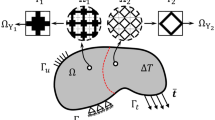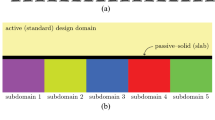Abstract
With the rapid developments of modern fabrication techniques, architected structures are increasingly used in many application areas, e.g., lightweight structures, heat exchangers, energy absorption components, aircraft engines, etc. To systematically design optimized architected structures with favorable manufacturability in terms of exact sizes and good connectivity, in the present work, an enhanced multidomain topology optimization method is developed. The design domain is divided into several subdomains and boundary layers between them first. Periodic base cells with exact sizes are distributed in each subdomain, and analyzed and optimized approximately based on the homogenization method with coarse meshes to reduce the numerical efforts. Besides, gradient boundary layers discretized by fine meshes are optimized between subdomains and boundaries to connect adjacent base cells with different patterns and address the boundary effect. Quadtree technology is used to match the meshes of different sizes. Numerical examples verify both the effectiveness and efficiency of the proposed approach for designing manufacturable optimized architected structures.



















Similar content being viewed by others
References
Schaedler TA, Carter WB (2016) Architected cellular materials. Annu Rev Mater Res 46:187–210. https://doi.org/10.1146/annurev-matsci-070115-031624
Zadpoor AA (2016) Mechanical meta-materials. Mater Horiz 3:371–381. https://doi.org/10.1039/C6MH00065G
Gibson LJ (2012) The hierarchical structure and mechanics of plant materials. J R Soc Interface 9:2749–2766. https://doi.org/10.1098/rsif.2012.0341
Aizenberg J (2005) Skeleton of euplectella sp.: structural hierarchy from the nanoscale to the macroscale. Science 309:275–278. https://doi.org/10.1126/science.1112255
Zheng XY, Lee H, Weisgraber TH et al (2014) Ultralight, ultrastiff mechanical metamaterials. Science 344:1373–1377. https://doi.org/10.1126/science.1252291
Meza LR, Das S, Greer JR (2014) Strong, lightweight, and recoverable three-dimensional ceramic nanolattices. Science 345:1322–1326. https://doi.org/10.1126/science.1255908
Lakes R (1987) Foam structures with a negative Poisson’s ratio. Science 235:1038–1040. https://doi.org/10.1126/science.235.4792.1038
Bückmann T, Kadic M, Schittny R, Wegener M (2015) Mechanical cloak design by direct lattice transformation. Proc Natl Acad Sci USA 112:4930–4934. https://doi.org/10.1073/pnas.1501240112
Osanov M, Guest JK (2016) Topology optimization for architected materials design. Ann Rev Mater Res 46:211–233. https://doi.org/10.1146/annurev-matsci-070115-031826
Meza LR, Zelhofer AJ, Clarke N et al (2015) Resilient 3D hierarchical architected metamaterials. Proc Natl Acad Sci USA 112:11502–11507. https://doi.org/10.1073/pnas.1509120112
Bendsoe MP, Sigmund O (2013) Topology optimization: theory, methods, and applications. Springer, Berlin. https://doi.org/10.1007/978-3-662-05086-6
Guo X, Cheng GD (2010) Recent development in structural design and optimization. Acta Mech Sinica 26:807–823. https://doi.org/10.1007/s10409-010-0395-7
Sigmund O, Maute K (2013) Topology optimization approaches. Struct Multidisc Optim 48:1031–1055. https://doi.org/10.1007/s00158-013-0978-6
Sivapuram R, Dunning PD, Kim HA (2016) Simultaneous material and structural optimization by multiscale topology optimization. Struct Multidiscip Optim 54:1267–1281. https://doi.org/10.1007/s00158-016-1519-x
Xu L, Cheng GD (2018) Two-scale concurrent topology optimization with multiple micro materials based on principal stress orientation. Struct Multidiscip Optim 57:2093–2107. https://doi.org/10.1007/s00158-018-1916-4
Deng JD, Chen W (2017) Concurrent topology optimization of multiscale structures with multiple porous materials under random field loading uncertainty. Struct Multidiscip Optim 56:1–19. https://doi.org/10.1007/s00158-017-1689-1
Gao J, Luo Z, Li H, Gao L (2019) Topology optimization for multiscale design of porous composites with multi-domain microstructures. Comput Methods Appl Mech Eng 344:451–476. https://doi.org/10.1016/j.cma.2018.10.017
Bourgat JF (1979) Numerical experiments of the homogenization method. In: Glowinski R, Lions JL, Laboria I (eds) Computing methods in applied sciences and engineering, 1977, I. Springer, Berlin, pp 330–356
Sanchez-Palencia E (1983) Homogenization method for the study of composite media. In: Verhulst F (ed) Asymptotic analysis II. Springer Berlin Heidelberg, Berlin, pp 192–214
Bendsøe MP, Kikuchi N (1988) Generating optimal topologies in structural design using a homogenization method. Comput Methods Appl Mech Eng 71:197–224. https://doi.org/10.1016/0045-7825(88)90086-2
Rodrigues H, Guedes JM, Bendsøe MP (2002) Hierarchical optimization of material and structure. Struct Multidiscip Optim 24:1–10. https://doi.org/10.1007/s00158-002-0209-z
Coelho PG, Fernandes PR, Guedes JM, Rodrigues HC (2007) A hierarchical model for concurrent material and topology optimisation of three-dimensional structures. Struct Multidiscip Optim 35:107–115. https://doi.org/10.1007/s00158-007-0141-3
Coelho PG, Fernandes PR, Rodrigues HC, Cardoso JB, Guedes JM (2009) Numerical modeling of bone tissue adaptation—a hierarchical approach for bone apparent density and trabecular structure. J Biomech 42:830–837. https://doi.org/10.1016/j.jbiomech.2009.01.020
Liu L, Yan J, Cheng G (2008) Optimum structure with homogeneous optimum truss-like material. Comput Struct 86:1417–1425. https://doi.org/10.1016/j.compstruc.2007.04.030
Niu B, Yan J, Cheng GD (2008) Optimum structure with homogeneous optimum cellular material for maximum fundamental frequency. Struct Multidiscip Optim 39:115–132. https://doi.org/10.1007/s00158-008-0334-4
Deng JD, Yan J, Cheng GD (2012) Multi-objective concurrent topology optimization of thermoelastic structures composed of homogeneous porous material. Struct Multidiscip Optim 47:583–597. https://doi.org/10.1007/s00158-012-0849-6
Guo X, Zhao XF, Zhang WS, Yan J, Sun GM (2015) Multiscalele robust design and optimization considering load uncertainties. Comput Methods Appl Mech Eng 283:994–1009. https://doi.org/10.1016/j.cma.2014.10.014
Du ZL, Zhou XY, Picelli R, Kim HA (2018) Connecting microstructures for multiscale topology optimization with connectivity index constraints. J Mech Des. https://doi.org/10.1115/1.4041176
Deng J, Pedersen CBW, Chen W (2019) Connected morphable components-based multiscale topology optimization. Front Mech Eng 14:129–140. https://doi.org/10.1007/s11465-019-0532-3
Zhou XY, Du ZL, Kim HA (2019) A level set shape metamorphosis with mechanical constraints for geometrically graded microstructures. Struct Multidiscip Optim 60:1–16. https://doi.org/10.1007/s00158-019-02293-9
Wang Y, Chen F, Wang MY (2017) Concurrent design with connectable graded microstructures. Comput Methods Appl Mech Eng 317:84–101. https://doi.org/10.1016/j.cma.2016.12.007
Li H, Luo Z, Gao L, Qin Q (2018) Topology optimization for concurrent design of structures with multi-patch microstructures by level sets. Comput Methods Appl Mech Eng 331:536–561. https://doi.org/10.1016/j.cma.2017.11.033
Alexandersen J, Lazarov BS (2015) Topology optimisation of manufacturable microstructural details without length scale separation using a spectral coarse basis preconditioner. Comput Methods Appl Mech Eng 290:56–182. https://doi.org/10.1016/j.cma.2015.02.028
Fu J, Xia L, Gao L et al (2019) Topology optimization of periodic structures with substructuring. J Mech Des 141:071403. https://doi.org/10.1115/1.4042616
Liu Y, Li Z, Wei P, Wang W (2018) Parameterized level-set based topology optimization method considering symmetry and pattern repetition constraints. Comput Methods Appl Mech Eng 340:1079–1101. https://doi.org/10.1016/j.cma.2018.04.034
Guedes J, Kikuchi N (1990) Preprocessing and postprocessing for materials based on the homogenization method with adaptive finite element methods. Comput Methods Appl Mech Eng 83:143–198. https://doi.org/10.1016/0045-7825(90)90148-f
Hassani B, Hinton E (1998) A review of homogenization and topology optimization I—homogenization theory for media with periodic structure. Comput Struct 69:707–717. https://doi.org/10.1016/s0045-7949(98)00131-x
Allaire G (1992) Homogenization and two-scale convergence. SIAM J Math Anal 23:1482–1518. https://doi.org/10.1137/0523084
Moses E, Fuchs MB, Ryvkin M (2002) Topological design of modular structures under arbitrary loading. Struct Multidiscip Optim 24:407–417. https://doi.org/10.1007/s00158-002-0254-7
Zuo ZH, Xie YM, Huang XD (2011) Optimal topological design of periodic structures for natural frequencies. J Struct Eng-ASCE 137:1229–1240. https://doi.org/10.1061/(asce)st.1943-541x.0000347
Xie YM, Zuo ZH, Huang XD, Rong JH (2011) Convergence of topological patterns of optimal periodic structures under multiple scales. Struct Multidiscip Optim 46:41–50. https://doi.org/10.1007/s00158-011-0750-8
Dumontet H (1985) Boundary layers stresses in elastic composites. Studies in Applied Mechanics. Elsevier 12:215–232. https://doi.org/10.1016/b978-0-444-42520-1.50014-1
Dumontet H (1986) Study of a boundary layer problem in elastic composite materials. Esaim-Math Model Num 20:265–286. https://doi.org/10.1051/m2an/1986200202651
Gupta AK (1978) A finite element for transition from a fine to a coarse grid. Int J Numer Methods Eng 12:35–45. https://doi.org/10.1002/nme.1620120104
Lo SH, Wu D, Sze KY (2010) Adaptive meshing and analysis using transitional quadrilateral and hexahedral elements. Finite Elem Anal Des 46:2–16. https://doi.org/10.1016/j.finel.2009.06.010
Tabarraei A, Sukumar N (2005) Adaptive computations on conforming quadtree meshes. Finite Elem Anal Des 41:686–702. https://doi.org/10.1016/j.finel.2004.08.002
Ball AA (1980) The interpolation function of a general serendipity rectangular element. Int J Numer Methods Eng 15:773–778. https://doi.org/10.1002/nme.1620150512
Cheng GD, Cai YW, Xu L (2013) Novel implementation of homogenization method to predict effective properties of periodic materials. Acta Mech Sin 29:550–556. https://doi.org/10.1007/s10409-013-0043-0
Bourdin B (2001) Filters in topology optimization. Int J Numer Methods Eng 50:2143–2158. https://doi.org/10.1002/nme.116
Svanberg K (1987) The method of moving asymptotes—a new method for structural optimization. Int J Numer Methods Eng 24:359–373. https://doi.org/10.1002/nme.1620240207
Zuo ZH, Huang XD, Yang XY, Rong JH, Xie YM (2013) Comparing optimal material microstructures with optimal periodic structures. Comp Mater Sci 69:137–147. https://doi.org/10.1016/j.commatsci.2012.12.006
Neves MM, Rodrigues H, Guedes JM (2000) Optimal design of periodic linear elastic microstructures. Comput Struct 76:421–429. https://doi.org/10.1016/s0045-7949(99)00172-8
Guo X, Zhang W, Zhong W (2014) Doing topology optimization explicitly and geometrically—a new moving morphable components based framework. J Appl Mech 81:081009. https://doi.org/10.1115/1.4027609
Liu C, Zhu Y, Sun Z et al (2018) An efficient moving morphable component (MMC)-based approach for multi-resolution topology optimization. Struct Multidisc Optim 58:2455–2479. https://doi.org/10.1007/s00158-018-2114-0
Wang F, Lazarov BS, Sigmund O (2011) On projection methods, convergence and robust formulations in topology optimization. Struct Multidisc Optim 43:767–784. https://doi.org/10.1007/s00158-010-0602-y
Liang Y, Cheng G (2019) Topology optimization via sequential integer programming and Canonical relaxation algorithm. Comput Methods Appl Mech Eng 348:64–96. https://doi.org/10.1016/j.cma.2018.10.050
Acknowledgements
The financial supports from the National Natural Science Foundation (11821202, 11732004, 12002077, 12002073), the National Key Research and Development Plan (2016YFB0201601), China Postdoctoral Science Foundation funded project (2020T130078, 2020M680944), Starting Grants at Dalian University of Technology (DUT20RC(3)020), Program for Changjiang Scholars, Innovative Research Team in University (PCSIRT) and 111 Project (B14013) are also gratefully acknowledged.
Author information
Authors and Affiliations
Corresponding authors
Additional information
Publisher's Note
Springer Nature remains neutral with regard to jurisdictional claims in published maps and institutional affiliations.
Rights and permissions
About this article
Cite this article
Liu, C., Du, Z., Zhang, W. et al. Design of optimized architected structures with exact size and connectivity via an enhanced multidomain topology optimization strategy. Comput Mech 67, 743–762 (2021). https://doi.org/10.1007/s00466-020-01961-8
Received:
Accepted:
Published:
Issue Date:
DOI: https://doi.org/10.1007/s00466-020-01961-8




